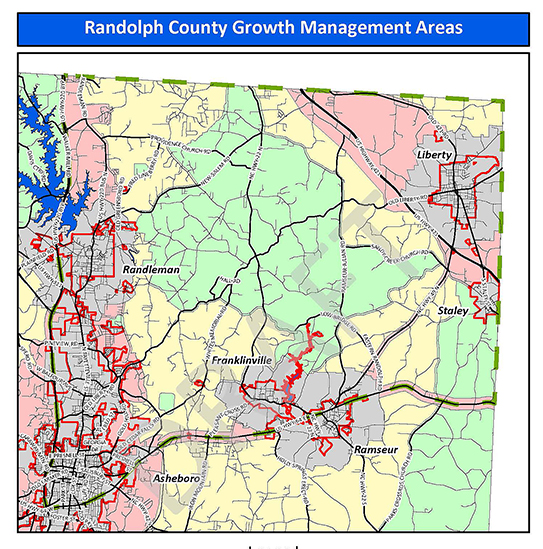Welcome!

‘Your chance to comment’
ASHEBORO — The public had an opportunity on June 29 to say what’s most important in updating Randolph County’s Growth Management Plan, focusing on the northeast quadrant that includes the Toyota Battery Plant.
With Toyota investing some $5 billion at the Greensboro Randolph Megasite, and Wolfspeed Semiconductors coming just across the Chatham County line, historic growth in the area is expected.
For that reason, the Randolph County Board of Commissioners in January entered into an agreement with the Piedmont Triad Regional Council (PTRC) to update the county’s Growth Management Plan (GMP). A steering committee meets regularly with the council and county staff to work on the plan and public meetings have been held for more input.
At the June 29 meeting, which included all five county commissioners and the Planning Board members, County Manager Hal Johnson told an audience in the McAnulty Room of the Board of Elections at Northgate Commons in Asheboro that the GMP sets policies for future growth. But there has not been an update since 2009.
The GMP, he said, “impacts you and your land. We’re trying to implement plans you want government to follow.” Change is coming, Johnson said, and the GMP process is to address those changes in a way that will enhance the region’s quality of life.
“This is a chance for you to comment with your input,” he said.
There will be public hearings on the GMP and then the steering committee will present a draft of the updated plan to the Randolph County Planning Board, which can accept or set aside portions of the plan. The GMP will then be sent to the county commissioners this fall for the final decision.
Jesse Day, the PTRC regional planning director, said it’s estimated that Toyota alone will bring 5,000 new residents to the area.
Jose Colon, PTRC regional planner, said that from public input so far, what’s important to people is agriculture, housing types, land usage and transportation corridors. “We keep fine-tuning the plan,” he said.
With the floor open to comments from the audience, one questioned who was to make the decisions. They were told that the PTRC staff works with the steering committee on a draft, which is sent to the Planning Board and then to the commissioners.
A woman said, “We’re being told this is the way it’s going to be. There should be more public notice. Residents have a lack of knowledge.”
Another person asked about the various colors on the map, denoting primary, secondary and rural growth areas. She wanted to know if a yellow area (primary growth) could be more toward green (rural growth). Day told her that there would be opportunities to do that.
The audience was then encouraged to look at categories on large posters and vote by placing sticky dots on areas they find most important to growth management. As a result:
— On the Agriculture and Farmland Preservation board, “update the Randolph County agriculture and farmland protection plan” received the most votes with 29, followed closely by “incentive land preservation” with 28.
— “Workforce housing development” with 12 votes led the way on the Residential Development poster. That was followed by “subdivision configuration and design” with 10 votes and “subdivision and overlay district” with 9.
— On the Commercial, Office and Institutional Development board, the top vote getter was “mixed uses” with 15 votes. The Industrial Development chart was led by “all industrial uses” with 26 votes.
— The Economic Growth category was overwhelmingly led by “support the local agricultural economy” with 57 votes. “Driveway connections” received 19 votes on the Transportation and Recreation board.
— The Public Infrastructure category was led by “public services” with 17 votes while “water and sewer extensions” received 15 votes. The Environmental and Water Quality board had 22 votes for “protect environment from industrial nuisance” and 18 for “protection of water critical areas.”
Melda Dyer, who had said during the comment period that “the decision is already made, they’re OK’ing doing away with farmland,” spoke later of her concerns with the plans to develop the northeast quadrant, which is heavily agricultural.
“This is much bigger than Randolph County, to me,” she said. “This is communism, not capitalism.”
But Dyer wasn’t placing blame on the commissioners or PTRC. “People are selling their land and growth is coming,” she said. “It’s not the county’s fault. We need to realize what we’re doing. We don’t have our priorities straight. We need to take care of our communities and our families and grow food, not just look at money.”
Dyer said she believes that forces beyond the county and region are at play. “I think there should be planning but if we slow down too much, we’ll be run over. It’s out of control. We need to do something about it. We need to get down on our knees and pray.”
Steering committee member Ken Austin denied that there was a conspiracy at play.
“There is a process,” he said. “Many man hours and woman hours have gone into this. Some have the impression that this is being done in a box, but there’s been a tremendous amount of input.”
Austin said any decision or policy can be appealed before the county commissioners. “Flexibility is built in. That’s the structure of zoning and rezoning.”
He said discussions are held at steering committee and public meetings and that all the involved municipalities have had opportunities for input.
For more details on the Growth Management Plan, visit https://www.randolphcountync.gov/512/GMP-Update.
